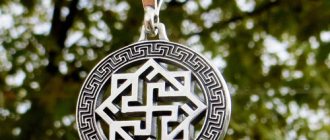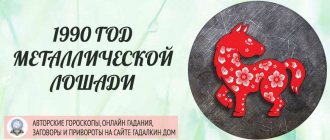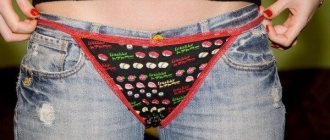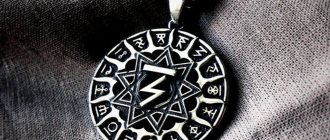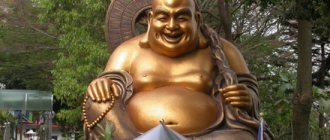Kolovrat is a symbol of the sun and has a long and interesting history. The Slavs, whose lives, events and holidays directly depended on the movement of the planet around the sun, used this image as a symbol of the eternal luminary. In their understanding, it was the celestial fireball that represented the focus of life, fertility and energy. Therefore, the symbol of the sun - a circle with rays extending from it - found wide popularity in Slavic mythology and was revered as a male sign of strength and courage, energy and victories. It was often used in Vedic rituals.
Most often among the Slavic peoples, the Kolovrat (a symbol of the world cycle) was used by the Krivichi of Smolensk land and the Vyatichi, but this amulet can be found in the north-west and north-east of Rus'. The period of appearance is considered to be the period of the 11th-13th centuries. The first silver lunars found date back to the 10th-11th centuries. By the 13th century, amulets with a cross appeared.
The meaning of the Kolovrat amulet
The Kolovrat amulet is made in the shape of a circle, the center of which is the point of departure of the rays. The meaning of the symbol is associated with isolation and movement. The first part of the word “kolo” means a closed circle. The second part of the “gate” corresponds to movement. When connecting two parts, the decoding says about moving in a circle.
Another Slavic designation is the trajectory of the sun across the sky, when the interaction of three gods is shown:
- Svarog is the god of fire.
- Dazhdbog - the giver of warmth, goodness and wealth.
- Perun is the thunder god.
This leads to the conclusion that when wearing an amulet, people wanted to receive the energy of the sun, heat and divine power.
Outwardly, it resembles the swastika sign, but is not directly related to it. It began in the times of the ancient Slavs, who used the symbol in rites and rituals. When using it, they tried to replenish energy from internal reserves and acquire additional strength from the gods to accomplish deeds.
What does it mean
Kolovrat is one of the most ancient amulets of our ancestors. This is a sign of the solar type, which is fraught with deep meaning. It means the eternal rotation of the sun, the change of day to night and the infinity of the universe. Hence another name – “solstice”.
The Slavic symbol Kolovrat personifies 3 powerful deities and their interaction:
- Svarog, lord of the sky.
- Dazhdbog, his son.
- Khorsa, guardian of the sun.
Obviously, not only the Slavs revered the sun and drew strength from it. Charms with images similar to Kolovrat are present in ancient Indo-European cultures. It is no coincidence that this sign was painted or embroidered on the fabric in which the sacred covenants of the gods were wrapped.
Types of Kolovrat amulet
The Slavic amulet is divided into types according to the number of rays:
- 4 – the symbol corresponds to fire. People who wear it attract the power of fire.
- 6 – speaks of protection by the thunder god Perun.
- 8 – combination of spiritual and material.
A Kolovrat with 8 rays is often found. The Slavs believed that it combined 4 elements and 4 seasons.
With eight rays, the amulet was associated with rebirth through constant movement.
Important! The outgoing rays of the Kolovrat are enclosed in a wheel, symbolizing the power of the god of fire Svarog. It enhances the effect of the amulet, giving infinity to a person’s energy.
Another classification is the division into types depending on the direction of the rays in the symbolic object.
The mystery of the symbol
Kolovrat symbolizes the solar disk and its constant rotation. It looks like a wheel (hence the first part of the name – “colo”). In the middle of the circle there are pairs of rays bent in one direction.
There are 3 options for symbol image:
- 4 – give support to the fire element and the protection of Dazhdbog;
- 6 – protection of Perun;
- 8 – intercession of Svarog and the power of the light gods.
"Vrat" means "rotation". The beams can rotate left and right. It is translated into modern Russian as “rotation of the wheel.”
It is interesting that in appearance Kolovrat resembles the famous swastika sign - once a symbol of Nazi Germany. There are even comparison photos online. However, it has nothing in common with fascism and violence. Apparently, the ancient sign, intended to serve good, was appropriated by the Nazis in order to enhance their power with solar energy.
Features of the direction of rays in Kolovrat
Due to the direction of the rays, the talisman can be called differently:
- In the direction of the sun's movement (clockwise) - Salt Kolovrat, which gives protection from evil spirits and gives energy and health.
- Counterclockwise - Anti-salt Kolovrat, which reveals magical abilities and imparts insight.
Depending on the direction of the rays, the amulet worn by women and men differed. The fairer sex had amulets with rays directed counterclockwise. Representatives of the stronger sex had to wear talismans with rays, the movement of which corresponded to the trajectory of the sun.
Example Anti-salt
In addition to protection from evil spirits and magical abilities, multidirectional rays symbolized:
| Clockwise (Posolon) | Counterclockwise (Anti-salt) |
| Prosperity | Life beyond death |
| Following orders | Connection with the other world |
| Connection with the Gods | Magic force |
| Good thoughts and actions | Strong premonitions for imminent events |
Important ! Among the Slavs, a woman who wore a Kolovrat with backward-directed rays received energy with a kind of protection from diseases and misfortunes.
Various image options
Externally, the ancient Slavic amulet is a circle, from the central part of which rays with curved ends fan out. They can look in different directions, which symbolically indicates their direction.
There are a large number of different options in which the image of the Kolovrat amulet is made. According to some statistics, they exceed one hundred. This, in particular, depends on the number of rays present in the image.
The pattern with four rays symbolizes the power of fire. The six rays personify the power of the great god Perun. The amulet with eight rays is the strongest. It is evidence of the combined power of all the solar gods of antiquity.
How does the talisman affect men?
Since the amulet was present among Slavic men in the form of a circle with rays directed clockwise, one could expect health and prosperity. He bestows victory and strength on the stronger sex.
To enhance the energy signal, men painted animal symbols on their talismans. For example, a talisman with a wolf characterizes the Kolovrat as a powerful and strong amulet. A man acquires the energy potential of an animal. The Slavs wearing the wolf sign wanted to be fast and dexterous in battle.
There were symbols with a bear, a raven or a rune. Each has its own meaning for men, based on the potential of the animal.
Example of a mascot with a bear
The warriors brought some kind of weapon, such as an ax, to the center. The owner of the amulet wanted to increase his fighting spirit and gain confidence in his courage. Such items symbolized good luck in battle and future victories over strong enemies.
Solar signs
A sun sign similar to Kolovrat is found among many peoples of antiquity, but it is more common among the Slavs. The Kolovorot is a Slavic symbol, the description of which was given above - this is one of the most powerful solar signs. Let's get to know them better. First of all, solar signs are amulets that protect their owner. Solar symbols were used by the inhabitants of Ancient Rus' to protect their homes from negative energy and evil spells. At the same time, the sun had several forms of image at once - morning, noon, evening, and together they made up the triune sun. There were the following solar signs:
- A simple solar symbol is an ordinary circle.
- On all four sides there is a circle with four rays inside.
- Six spokes - Thunder wheel.
- Eight spokes.
- The abundance of spokes is a multi-ray solar symbol. The knitting needles could be either straight or curved.
- The artistic symbol is a circle with various decorations.
The sun was perceived by the ancient Slavs as the personification of the victory of good over evil, therefore its symbols were used as protective talismans. And the Slavic sun god enjoyed special love and respect.
Our distant ancestors began to wear the Kolovrat amulet from early childhood, so the solar symbol was often carved on a cradle or cradle. This protected the baby from evil spells and the evil eye. Later, the grown-up boy began to wear the amulet around his neck or on his clothes in the form of embroidery. Often such a talisman had magical effects and was used in sacrifices and other secret rituals.
Connection with the modern world
Nowadays, there are people wearing the Kolovrat amulet. Many people associate its presence with the desire to acquire:
- Strength of spirit.
- Health.
- Positive attitude towards life.
- Protection from negative emotions and impressions.
Some young people associate it with magical protection and the power of the solar flame. Therefore, it is more often present among magicians and psychics.
The power of the talisman allows you to master the energy of the sun, necessary to achieve goals and fulfill desires. It helps you get out of difficult situations without damage and become more successful.
Important! Before using the Kolovrat, you should properly charge and clean it in order to take advantage of the magical properties and energy of the item.
Tattoo
Tattoo "Kolovrat"
It is preferable to apply the Kolovrat symbol in the form of a one-color tattoo. The most optimal areas for this are the following:
- neck;
- chest area;
- shoulder blades;
- forearms.
How to activate the amulet
It is recommended to make the amulet yourself. Many people purchase a ready-made version that requires charging and cleaning. If the process of getting rid of someone else’s energy has not gone through, its effect is weakened or directed inappropriately. It is necessary to clean an item when receiving it from another person and at least twice a year. When worn, it takes on negativity and stress, and when cleansed, it resets and recharges.
Afterwards, it requires charging to saturate itself with its own energy. The procedure is performed according to the following scheme:
- The bearer of the symbol squeezes it in his hand.
- Mentally you need to ask for intercession, health and benefits.
- Put the amulet on a rope and carry it with you for 3 days.
- It is forbidden to remove the amulet so that the invested forces are not lost.
Activation is a necessary step in using the talisman.
When charging, a person mentally voices his desires and urgent needs. The strength and power of the talisman depends on the correct execution of actions and maintaining it on your body for the specified time.
Origin story
Kolovrat was popular in Ancient Rus', when it was believed that the sun was the creator of all life on earth, and its sign retained a special energy. The amulet was painted on things, the walls of houses, and embroidered on clothes to convey a piece of powerful protection.
Scientists were able to decipher the meaning of the symbol. If you connect the North Star, the points of the winter and summer solstice, the spring and autumn equinox with a conventional line, you get Kolovrat. Therefore, a version was put forward that such an amulet was worn not only for protection, but also to navigate by the night luminaries.
What materials to make it from?
When you want to make a talisman yourself, different materials are used. The most popular:
- Metal products - made of gold, silver, copper and brass. Such amulets are durable. They are resistant to external influences. In practice, the type of material is not given special importance, but for some it is useful to know that gold Kolovrat is suitable for modest people. They will be more confident and empowered to achieve their goals. Silver items are chosen by young men and women.
- Wood – any wood is chosen as the base, from ordinary deciduous wood to fruit wood. Slavic men made it from oak, which gives strength and power. Women had amulets made of birch, which meant tenderness and care.
- Bone products are characterized by a fusion of the energy of the carrier and the source material. If you want to make a bone amulet, you need to take into account that the bones of noble animals, for example, a bull, are taken as the basis.
It is prohibited to use natural animal leather. This will affect the power of the amulet. The exception is when using a foundation obtained during ritual ceremonies.
Metal talisman
Orthodoxy: XV century
On August 12, 1479, Moscow Metropolitan Gerontius consecrated the main cathedral church of the Russian Church - the Assumption Cathedral in Moscow. During its consecration, the Metropolitan performed a religious procession against salt. Grand Duke Ivan III found out about this; unknown people reported this to him. The prince was dissatisfied with this and was angry with the metropolitan. A dispute began between the prince and the metropolitan; to resolve the dispute, they began to look in books for how to correctly perform movements during worship. But they found nothing in them. The archimandrites and abbots came out in defense of the metropolitan. One abbot, justifying the metropolitan, said that he saw the anti-salt procession taking place on Mount Athos. To support his opinion, the prince called Archbishop Vassian of Rostov and Archimandrite Gennady of the Chudov Monastery. In contrast to their opinion, the Metropolitan cited the fact that the deacon performs incense around the throne against the sun. The archbishop and archimandrite, in support of their point of view, said the following: “The righteous sun is Christ, come to death and hell, and free souls, and for this reason, they say, they come to Easter, they are also prefigured at Matins.” The prince remained unconvinced and forbade the metropolitan to consecrate newly built churches, of which there were quite a few in Moscow. After the invasion of Akhmat in 1480, the dispute was resumed in 1481, on July 22. There were only two people on the side of the Grand Duke: Archbishop Joasaph of Rostov (Vassian had already died) and Archimandrite Gennady. Everyone else was on the side of the Metropolitan. The prince stubbornly stood his ground, because of this, the metropolitan left for the Simonov Monastery and announced to the prince that he would completely leave the metropolitan see if the prince did not submit. The prince reconciled himself and sent his son to the metropolitan with a request to return to his throne. The Metropolitan did not return. Then the prince himself went to the metropolitan, declared himself guilty of everything, promised to obey the metropolitan in everything related to the direction of movement, then he gave it to the will of the metropolitan, as he ordered and as it was in the old days.
Cleansing
Cleansing and activation are carried out on the equinox or solstice days. This is due to the increased energy of the sun transmitted to the amulet. The effectiveness of talismans when charging these days is maximum. They convey great power, allowing a person to gain strength and get rid of negative emotions.
The cleaning procedure involves performing stages when exposed to three elements:
- The first stage involves purification with water from nature (lake, sea, river, stream). It is necessary to wash the object so that the extraneous energy leaves and the negativity of other people dissolves. When it is not possible to go to the source, it is allowed to bathe the item in running water. The main condition is that it must move. Do not put the amulet in standing water (mug, jug). After immersing the talisman, you should wait several hours to remove the foreign energy.
- At the second stage, you should bury the amulet in damp soil for several days. She takes away the negativity, clearing the amulet of other energy.
- The third stage is accompanied by fire aging, when the object is placed in a fire. For a long time, a flame from a tree ignited with the help of branches, which had previously been struck by lightning, was used. Nowadays it’s difficult to find such a thing, so they take a candle flame (church ones won’t do). The amulet is passed through it several times.
Burying in the ground for purification
While it is not difficult to carry out all three procedures with metal and bone objects, wooden items can be damaged in a fire. After instillation, you need to spray it with water and immediately carry it through the flame 3 times.
Orthodoxy: XV century
On August 13, 1479, Moscow Metropolitan Gerontius consecrated the main cathedral church of the Russian Church - the Assumption Cathedral in Moscow. During its consecration, the Metropolitan performed a religious procession against salt. Grand Duke Ivan III found out about this; unknown people reported this to him. The prince was dissatisfied with this and was angry with the metropolitan. A dispute began between the prince and the metropolitan; to resolve the dispute, they began to look in books for how to correctly perform movements during worship. But they found nothing in them. The archimandrites and abbots came out in defense of the metropolitan. One abbot, justifying the metropolitan, said that he saw the anti-salt procession taking place on Mount Athos. To support his opinion, the prince called Archbishop Vassian of Rostov and Archimandrite Gennady of the Chudov Monastery. In contrast to their opinion, the Metropolitan cited the fact that the deacon performs incense around the throne against the sun. The archbishop and archimandrite, in support of their point of view, said the following: “The righteous sun is Christ, come to death and hell, and free souls, and for this reason, they say, they come to Easter, they are also prefigured at Matins.” The prince remained unconvinced and forbade the metropolitan to consecrate newly built churches, of which there were quite a few in Moscow. After the invasion of Akhmat in 1480, the dispute was resumed in 1481, on July 22. There were only two people on the side of the Grand Duke: Archbishop Joasaph of Rostov (Vassian had already died) and Archimandrite Gennady. Everyone else was on the side of the Metropolitan. The prince stubbornly stood his ground, because of this, the metropolitan left for the Simonov Monastery and announced to the prince that he would completely leave the metropolitan see if the prince did not submit. The prince reconciled himself and sent his son to the metropolitan with a request to return to his throne. The Metropolitan did not return. Then the prince himself went to the metropolitan, declared himself guilty of everything, promised to obey the metropolitan in everything related to the direction of movement, then he gave it to the will of the metropolitan, as he ordered and as it was in the old days.
Can Christians wear it?
Before Christianity, people believed in Slavic gods. Afterwards, the Christian religion outlived the Slavic belief, so their signs have differently charged energy. Christians are prohibited from wearing Kolovrat. Their religion does not accept such rituals.
Wearing a talisman in the modern world is not considered evil or an example of following the swastika. Kolovrat in the form of a circle with rays gives strength to a person and helps to start things. You can simply make it yourself from wood or order it from a workshop from gold or silver. A properly cleaned and charged talisman will provide the energy of solar movement for a long time.
Signs of a “used” medallion
Any amulet has its own deadlines. If it constantly absorbs negative energy and deflects blows, it will quickly lose its effect. Owners who often have to attend events and encounter unfriendly people need to clean the amulet once a month using fire or salt. You can also leave it during daylight hours in the sun.
Kolovrat should be cleaned regularly using fire and salt.
The following signs indicate that the medallion has already served its purpose:
- cracks;
- deformation;
- darkening on the surface.
You cannot throw away the security sign. Gold, silver and metal are buried. This is done in a sparsely populated place and away from your home. Wood and fabric products are burned. Before disposal, you need to thank the amulet for your help.
Orthodoxy: XV century
On August 12, 1479, Moscow Metropolitan Gerontius consecrated the main cathedral church of the Russian Church - the Assumption Cathedral in Moscow. During its consecration, the Metropolitan performed a religious procession against salt. Grand Duke Ivan III found out about this; unknown people reported this to him. The prince was dissatisfied with this and was angry with the metropolitan. A dispute began between the prince and the metropolitan; to resolve the dispute, they began to look in books for how to correctly perform movements during worship. But they found nothing in them. The archimandrites and abbots came out in defense of the metropolitan. One abbot, justifying the metropolitan, said that he saw the anti-salt procession taking place on Mount Athos. To support his opinion, the prince called Archbishop Vassian of Rostov and Archimandrite Gennady of the Chudov Monastery. In contrast to their opinion, the Metropolitan cited the fact that the deacon performs incense around the throne against the sun. The archbishop and archimandrite, in support of their point of view, said the following: “The righteous sun is Christ, come to death and hell, and free souls, and for this reason, they say, they come to Easter, they are also prefigured at Matins.” The prince remained unconvinced and forbade the metropolitan to consecrate newly built churches, of which there were quite a few in Moscow. After the invasion of Akhmat in 1480, the dispute was resumed in 1481, on July 22. There were only two people on the side of the Grand Duke: Archbishop Joasaph of Rostov (Vassian had already died) and Archimandrite Gennady. Everyone else was on the side of the Metropolitan. The prince stubbornly stood his ground, because of this, the metropolitan left for the Simonov Monastery and announced to the prince that he would completely leave the metropolitan see if the prince did not submit. The prince reconciled himself and sent his son to the metropolitan with a request to return to his throne. The Metropolitan did not return. Then the prince himself went to the metropolitan, declared himself guilty of everything, promised to obey the metropolitan in everything related to the direction of movement, then he gave it to the will of the metropolitan, as he ordered and as it was in the old days.
